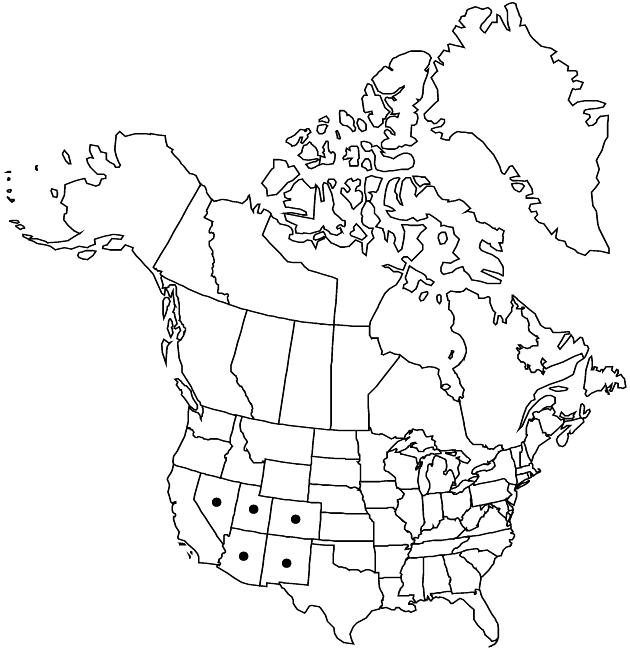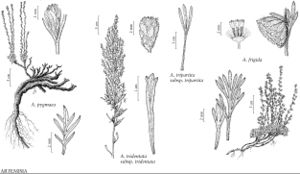Difference between revisions of "Artemisia pygmaea"
Proc. Amer. Acad. Arts 21: 413. 1886.
FNA>Volume Importer |
imported>Volume Importer |
||
| (5 intermediate revisions by 2 users not shown) | |||
| Line 8: | Line 8: | ||
}} | }} | ||
|common_names=Pygmy sage | |common_names=Pygmy sage | ||
| + | |special_status={{Treatment/ID/Special_status | ||
| + | |code=F | ||
| + | |label=Illustrated | ||
| + | }}{{Treatment/ID/Special_status | ||
| + | |code=E | ||
| + | |label=Endemic | ||
| + | }} | ||
|basionyms= | |basionyms= | ||
|synonyms={{Treatment/ID/Synonym | |synonyms={{Treatment/ID/Synonym | ||
|name=Seriphidium pygmaeum | |name=Seriphidium pygmaeum | ||
|authority=(A. Gray) W. A. Weber | |authority=(A. Gray) W. A. Weber | ||
| + | |rank=species | ||
}} | }} | ||
|hierarchy=Asteraceae;Asteraceae tribe Anthemideae;Artemisia;Artemisia subg. Tridentatae;Artemisia pygmaea | |hierarchy=Asteraceae;Asteraceae tribe Anthemideae;Artemisia;Artemisia subg. Tridentatae;Artemisia pygmaea | ||
| Line 36: | Line 44: | ||
-->{{#Taxon: | -->{{#Taxon: | ||
name=Artemisia pygmaea | name=Artemisia pygmaea | ||
| − | |||
|authority=A. Gray | |authority=A. Gray | ||
|rank=species | |rank=species | ||
| Line 50: | Line 57: | ||
|publication title=Proc. Amer. Acad. Arts | |publication title=Proc. Amer. Acad. Arts | ||
|publication year=1886 | |publication year=1886 | ||
| − | |special status= | + | |special status=Illustrated;Endemic |
| − | |source xml=https:// | + | |source xml=https://bitbucket.org/aafc-mbb/fna-data-curation/src/2e0870ddd59836b60bcf96646a41e87ea5a5943a/coarse_grained_fna_xml/V19-20-21/V19_872.xml |
|tribe=Asteraceae tribe Anthemideae | |tribe=Asteraceae tribe Anthemideae | ||
|genus=Artemisia | |genus=Artemisia | ||
Latest revision as of 19:57, 5 November 2020
Shrubs, 5–10 cm, slightly aromatic; not root-sprouting (caudices coarsely woody, branched). Stems pale to light brown (stiffly erect, densely clothed with appressed foliage), sparsely tomentose. Leaves persistent (sessile, rigid), bright green; blades oblong to ovate, 0.3–0.5 × 0.2–0.3 cm, pinnately lobed (nearly to midribs, 1/3+ widths of blades, lobes 3–7, divergent), faces glabrous or sparsely tomentose, resinous. Heads (sessile, erect) in paniculiform to racemiform arrays (1–)2–3 × 0.5–1 cm. Involucres narrowly turbinate, 2–3 × 3–4 mm. Phyllaries (green) narrowly lanceolate (midribs prominent), glabrous or sparsely tomentose. Florets 2–6; corollas 2.5–3 mm, glandular (style branches flat, erose, exsert). Cypselae (prismatic) 0.4–0.5 mm, glabrous, resinous. 2n = 18.
Phenology: Flowering mid summer–fall.
Habitat: Fine-textured soils of gypsum or shale
Elevation: 1500–1800 m
Distribution

Ariz., Colo., Nev., N.Mex., Utah.
Discussion
Artemisia pygmaea is a distinctive, faintly aromatic shrublet, often mistaken for something other than a sagebrush. In early spring its stiff, bright green, deeply pinnatifid leaves are reminiscent of some prickly member of Polemoniaceae. After flowering, its heads and narrow panicles easily identify it as a member of Artemisia; it is unlike other members of the subgenus (which typically have 3-lobed leaves in fascicled lateral shoots). The molecular analysis by L. E. Watson et al. (2002) supported its phylogenetic alignment within subg. Tridentatae.
Selected References
None.
